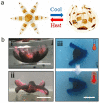Four-Dimensional-Printed Microrobots and Their Applications: A Review
- PMID: 37630143
- PMCID: PMC10456732
- DOI: 10.3390/mi14081607
Four-Dimensional-Printed Microrobots and Their Applications: A Review
Abstract
Owing to their small size, microrobots have many potential applications. In addition, four-dimensional (4D) printing facilitates reversible shape transformation over time or upon the application of stimuli. By combining the concept of microrobots and 4D printing, it may be possible to realize more sophisticated next-generation microrobot designs that can be actuated by applying various stimuli, and also demonstrates profound implications for various applications, including drug delivery, cells delivery, soft robotics, object release and others. Herein, recent advances in 4D-printed microrobots are reviewed, including strategies for facilitating shape transformations, diverse types of external stimuli, and medical and nonmedical applications of microrobots. Finally, to conclude the paper, the challenges and the prospects of 4D-printed microrobots are highlighted.
Keywords: 4D-printed; applications; medical; microrobots; nonmedical; shape reversible; stimuli-responsive.
Conflict of interest statement
The authors declare no conflict of interest.
Figures








Similar articles
-
3D-printed microrobots for biomedical applications.Biomater Sci. 2024 Aug 20;12(17):4301-4334. doi: 10.1039/d4bm00674g. Biomater Sci. 2024. PMID: 39041236 Review.
-
3D-printed microrobots from design to translation.Nat Commun. 2022 Oct 5;13(1):5875. doi: 10.1038/s41467-022-33409-3. Nat Commun. 2022. PMID: 36198675 Free PMC article. Review.
-
Light-Driven Microrobots for Targeted Drug Delivery.ACS Biomater Sci Eng. 2024 Sep 9;10(9):5562-5594. doi: 10.1021/acsbiomaterials.4c01191. Epub 2024 Aug 15. ACS Biomater Sci Eng. 2024. PMID: 39147594 Review.
-
Recent Advances in 4D Printing of Advanced Materials and Structures for Functional Applications.Adv Mater. 2024 Aug;36(34):e2312263. doi: 10.1002/adma.202312263. Epub 2024 Mar 27. Adv Mater. 2024. PMID: 38439193 Review.
-
Responsive Hydrogel-Based Modular Microrobots for Multi-Functional Micromanipulation.Small. 2024 Nov;20(47):e2404311. doi: 10.1002/smll.202404311. Epub 2024 Jul 23. Small. 2024. PMID: 39040007 Free PMC article.
Cited by
-
Treatment of lung diseases via nanoparticles and nanorobots: Are these viable alternatives to overcome current treatments?Mater Today Bio. 2025 Feb 26;31:101616. doi: 10.1016/j.mtbio.2025.101616. eCollection 2025 Apr. Mater Today Bio. 2025. PMID: 40124344 Free PMC article. Review.
-
Metareview: a survey of active matter reviews.Eur Phys J E Soft Matter. 2025 Mar 4;48(3):12. doi: 10.1140/epje/s10189-024-00466-z. Eur Phys J E Soft Matter. 2025. PMID: 40035927 Free PMC article. Review.
References
-
- Zhang L., Abbott J.J., Dong L., Kratochvil B.E., Bell D., Nelson B.J. Artificial Bacterial Flagella: Fabrication and Magnetic Control. Appl. Phys. Lett. 2009;94:064107. doi: 10.1063/1.3079655. - DOI
-
- Vrba J., Maslen C., Maxova J., Duras J., Rehor I., Mares J. An Automated Platform for Assembling Light-Powered Hydrogel Microrobots and Their Subsequent Chemical Binding [Formula Presented] J. Comput. Sci. 2021;55:101446. doi: 10.1016/j.jocs.2021.101446. - DOI
-
- Luo M., Feng Y., Wang T., Guan J. Micro-/Nanorobots at Work in Active Drug Delivery. Adv. Funct. Mater. 2018;28:1706100. doi: 10.1002/adfm.201706100. - DOI
Publication types
Grants and funding
LinkOut - more resources
Full Text Sources

